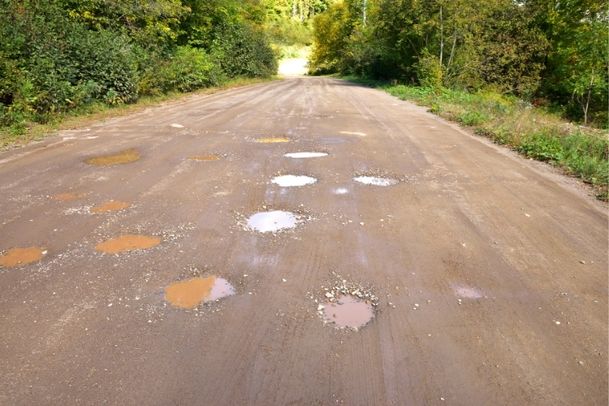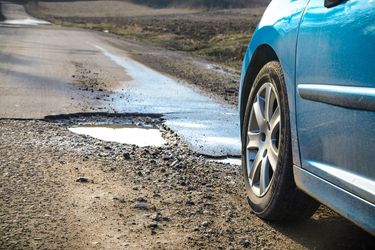
Written by Kayla Jane Barrie Mar 18, 2025 5 mins read

After weeks of freezing and thawing temperatures, potholes begin to surface across the city. This surge in weather wreaks havoc on roads and vehicles.
Potholes are formed when liquid seeps into the gravel beneath the pavement through an existing crack or hole. It begins to freeze and melt all while the ground expands and contracts, compacting and eventually collapsing.
The infrastructure in roads is aging, and dramatic shifts in climate are some of the factors contributing to the creation of potholes. As of March 2025, there were over 63,020 pothole repairs made in Toronto alone. The city repaired 201,000 potholes on its streets in 2023, up from nearly 179,000 in 2022.
Potholes are one of the dangers of spring driving across Canada that we need to be cautious of. Here’s what to do when you approach them on the road, how to deal with repairs, and if your insurer can help with the expense of a pothole claim.
CAA’s report, Cost of Poor Roads in Canada, found that Canadian drivers incur an extra $126 annually due to poor quality roads. This adds up to $3 billion for drivers across the country.
Whether you are driving in the city or the country, potholes can do serious harm to your car. Here is an overview of the most common types of damage and the associated costs.
The speed at which you hit the pothole and its depth will affect the extent of the damage.
When you are getting Ontario car insurance, make sure you are covered for pothole damages. If you need to submit a car insurance claim for pothole damage, you can seek support from your insurer. Most policies will cover the damages from hitting a pothole, as long as you have the right coverage in place.
Hitting a pothole is considered a single-vehicle collision. This means you would need collision or all perils insurance. If you have opted out of these options, you’ll have to cover repairs yourself. Keep in mind that some insurance companies may classify it as an at-fault claim, so do your research before submitting it to calculate if it’s worth it.
Your first concern may be that your car is damaged beyond repair when you hit a pothole, but your priority should be the safety of yourself and other drivers. Here’s what to do when you encounter a pothole driving:

On some roads, it isn’t possible to completely avoid hitting a pothole. Here are four easy tips to remember next time the road you are is ridden with these sneaky hazards:
Toronto spends between $4 million and $5 million to address potholes yearly. In 2020, CityNews reported there was a pothole so bad that it damaged at least 12 vehicles.
Luckily, the city has implemented an online system to report potholes, or you can use the 311 app.
After receiving the report, they aim to have repairs done within four days on busy roads. On side streets, they have 30 days to repair it.
Toronto car insurance are some of the highest in the province – but it doesn’t always help protect you in the case of hitting a pothole.
Some cities and towns may pay for damages that occurred from driving into a pothole. There is a list of rules that determine the criteria for City of Toronto pothole claims.
After you submit it, there will be an investigation. The City’s insurance adjusters will determine if they are responsible for your loss or damages. This can take anywhere from 30 to 90 days. If it is denied, you can proceed with legal action.
Depending on the age and size of the pothole, they will decide who is liable. You can learn more about the “Minimum Maintenance Standards for Highways in the City of Toronto” (MMS) online.
You can claim damages from potholes with your provider if you have collision insurance or another enhancement that protects you beyond the basics. If you have any questions about what your policy includes, contact ThinkInsure.
You may have to pay your car insurance deductible if you submit a pothole related claim. It depends on what your policy has listed in that section. If your insurer succeeds at getting reimbursement from the local government, you may receive the deductible back.
It is possible to sue the city for pothole damages, but it’s not easy. It’s challenging to succeed in suing the city because they have strict guidelines of what constitutes their liability. Note that if you face personal injuries and you’re waiting on the city, SABS may be available to support you.
Hitting a pothole can cause tires to lose air because of the force or sudden air shift inside the tire. It can cause a sidewall to blow out, or the seal will be lost, therefore, air will leak out.
No matter what season it is, keep your eyes on the road, practice proper vehicle maintenance to ensure your ride is ready for whatever happens on the road by updating your quote.
| Categories | Auto |
|---|---|
| Tags | Repairs and MaintenanceAuto Coverage |
Read our insurance blog to get helpful tips, information and news.
Has your car been totalled in an accident? Is your car a write off? Learn about vehicle write offs for a total loss insurance claim.
Get the facts on Toronto's auto theft problem. We break down the data, reveal the most-stolen vehicles (including the Honda CR-V and Lexus RX 350), and show which neighbourhoods are most affected.
Dive into the world of auto theft with our blog on the most stolen cars in Canada. See the most stolen cars across Canada, including provincial lists for Ontario and Quebec, and learn how high-risk models can affect your car insurance premiums.
Drive safe this winter! Check out these tips for driving in snowy and icy conditions in Ontario. Get other helpful info and FAQs on winter driving.